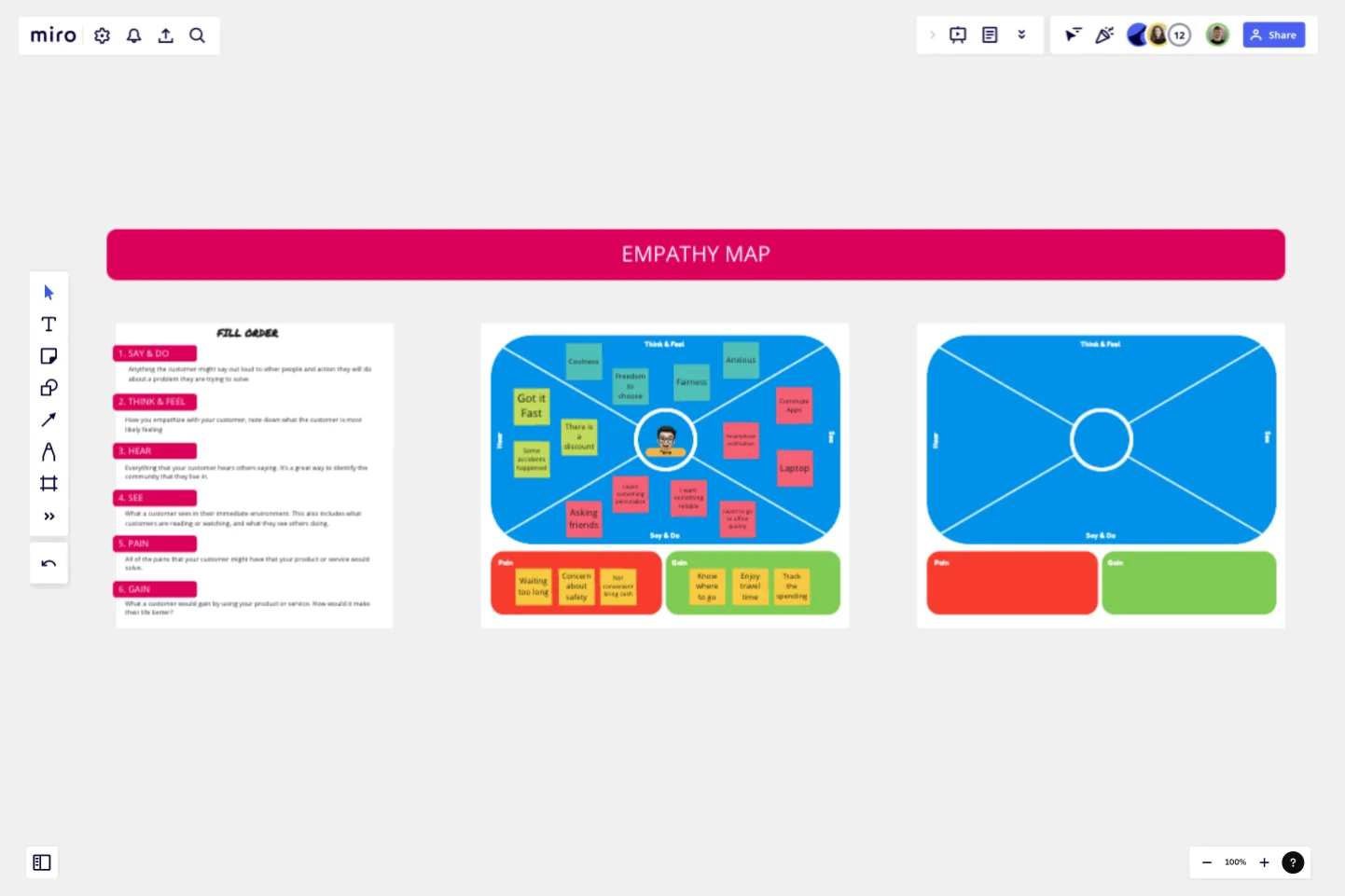Empathy Map Pro
Empathy maps are best used from the very beginning of the design process.
The mapping process can help synthesize research observations and reveal deeper insights about a user’s needs
Why Use Empathy Map?
Capture who a user or persona is. The empathy-mapping process helps distill and categorize your knowledge of the user into one place.
Communicate a user or persona to others: An empathy map is a quick, digestible way to illustrate user attitudes and behaviors. Once created, it should act as a source of truth throughout a project and protect it from bias or unfounded assumptions.
Collect data directly from the user. When empathy maps are filled in directly by users, they can act as a secondary data source and represent a starting point for a summary of the user session. Moreover, the interviewer may glean feelings and thoughts from the interviewee that otherwise would have remained hidden.
How does Empathy Map work?
Define the persona of target users and put into center of map, then fill all the 6 boxes accordingly.
Say & Do: Anything the customer might say out loud to other people and action they will do about a problem they are trying to solve.
Think & Feel: How you empathize with your customer, note down what the customer is most likely feeling.
Hear: Everything that your customer hears others saying. It’s a great way to identify the community that they live in.
See: What a customer sees in their immediate environment. This also includes what customers are reading or watching, and what they see others doing.
Pain: All of the pains that your customer might have that your product or service would solve.
Gain: What a customer would gain by using your product or service. How would it make their life better?
This template was created by Indra Kusuma.
Get started with this template right now.
Job Map Template
Works best for:
Design, Desk Research, Mapping
Want to truly understand your consumers’ mindset? Take a look at things from their perspective — by identifying the “jobs” they need to accomplish and exploring what would make them “hire” or “fire” a product or service like yours. Ideal for UX researchers, job mapping is a staged process that gives you that POV by breaking the “jobs” down step by step, so you can ultimately offer something unique, useful, and different from your competitors. This template makes it easy to create a detailed, comprehensive job map.
Official 5-Day Design Sprint
Works best for:
Design, Desk Research, Sprint Planning
The goal of a Design Sprint is to build and test a prototype in just five days. You'll take a small team, clear the schedule for a week, and rapidly progress from problem to tested solution using a proven step-by-step checklist. Steph Cruchon of Design Sprint created this template for Miro in collaboration with design sprint gurus at Google. This Design Sprint template is designed specifically for remote sprints so you can run productive and efficient sprints with colleagues around the world.
Executive Summary Template
Works best for:
Leadership, Project Management, Documentation
Pique their curiosity. Get them excited. Inspire them to keep reading, diving further into your proposal details. That’s what a good executive summary has the power to do—and why it’s a crucial opening statement for business plans, project plans, investment proposals, and more. Use this template to create an executive summary that starts building belief, by answering high-level questions that include: What is your project? What are the goals? How will you bring your skills and resources to the project? And who can expect to benefit?
Proto Persona Template
Works best for:
UX, UX Research, Product Design
The Proto Persona Template is tailored to capture the essence of hypothetical user segments. It encapsulates key attributes such as user needs, behaviors, and potential pain points. One of its standout benefits is its ability to foster empathy. By visualizing and understanding these preliminary user profiles, design and strategy teams can tap into a deeper connection with their target audience, ensuring that solutions resonate authentically and address genuine needs.
Co-Creation Template
Works best for:
Design
The Co-Creation Template enables the visual expression of ideas using essential elements. Analysis of these creations identifies explicit and implicit needs. For instance, a human resources team may use symbols to envision their ideal work environment. The output reflects people's desires and expectations.
Service Blueprint by Hyperact
Works best for:
Research & Design
The Service Blueprint template is perfect for visualizing the orchestration of service components. It maps out frontstage and backstage elements, helping you analyze and enhance customer experiences. Use this template to align teams, identify pain points, and streamline processes, ensuring a seamless service delivery. It's ideal for creating a shared understanding of service dynamics among stakeholders and collaborators.
